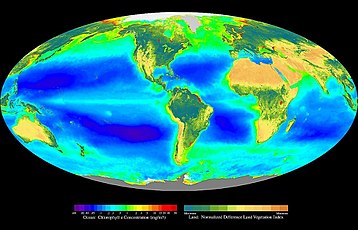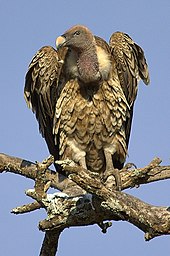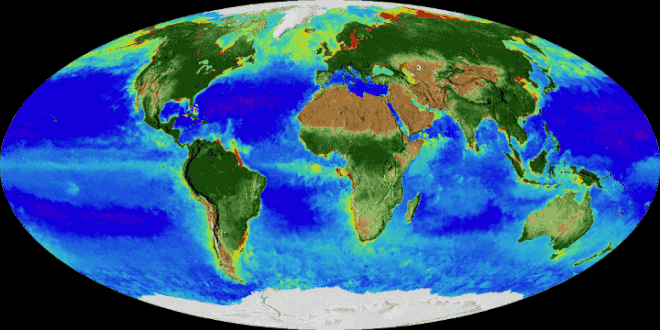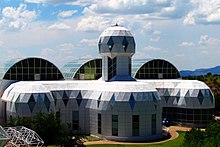Biosphere

The biosphere (from
In a general sense, biospheres are any closed, self-regulating systems containing ecosystems. This includes artificial biospheres such as Biosphere 2 and BIOS-3, and potentially ones on other planets or moons.[5]
Origin and use of the term

The term "biosphere" was coined in 1875 by geologist
While the concept has a
Narrow definition
Geochemists define the biosphere as being the total sum of living organisms (the "
The Second International Conference on Closed Life Systems defined biospherics as the science and technology of analogs and
Earth's biosphere
Overview
Currently, the total number of living cells on the Earth is estimated to be 1030; the total number since the beginning of Earth, as 1040, and the total number for the entire time of a habitable planet Earth as 1041.[9][10] This is much larger than the total number of estimated stars (and Earth-like planets) in the observable universe as 1024, a number which is more than all the grains of beach sand on planet Earth;[11][12][13][14] but less than the total number of atoms estimated in the observable universe as 1082;[15] and the estimated total number of stars in an inflationary universe (observed and unobserved), as 10100.[16]
Age

The
Extent

Every part of the planet, from the
There are more extreme examples for life on the planet: Rüppell's vulture has been found at altitudes of 11,300 metres (37,100 feet; 7.0 miles); bar-headed geese migrate at altitudes of at least 8,300 m (27,200 ft; 5.2 mi); yaks live at elevations as high as 5,400 m (17,700 ft; 3.4 mi) above sea level; mountain goats live up to 3,050 m (10,010 ft; 1.90 mi). Herbivorous animals at these elevations depend on lichens, grasses, and herbs.
Life forms live in every part of the Earth's biosphere, including
Microorganisms, under certain test conditions, have been observed to
Earth's biosphere is divided into a number of
Annual variation

Artificial biospheres

Experimental biospheres, also called closed ecological systems, have been created to study ecosystems and the potential for supporting life outside the Earth. These include spacecraft and the following terrestrial laboratories:
- Biosphere 2 in Arizona, United States, 3.15 acres (13,000 m2).
- BIOS-1, BIOS-2 and BIOS-3 at the Institute of Biophysics in Krasnoyarsk, Siberia, in what was then the Soviet Union.[42]
- Biosphere J (CEEF, Closed Ecology Experiment Facilities), an experiment in Japan.[43][44]
- Micro-Ecological Life Support System Alternative (Universitat Autònoma de Barcelona
Extraterrestrial biospheres
No biospheres have been detected beyond the Earth; therefore, the existence of extraterrestrial biospheres remains hypothetical. The
Based on observations by the
It is also possible that artificial biospheres will be created in the future, for example with the terraforming of Mars.[49]
See also
- Climate system
- Cryosphere
- Thomas Gold
- Circumstellar habitable zone
- Homeostasis
- Life-support system
- Man and the Biosphere Programme
- Montreal Biosphere
- Noosphere
- Rare biosphere
- Shadow biosphere
- Simple biosphere model
- Soil biomantle
- Wardian case
- Winogradsky column
References
- ^ "Biosphere" in The Columbia Encyclopedia, 6th ed. (2004) Columbia University Press.
- PMID 10670014.
- ^ ISBN 978-0-13-250882-7. Archivedfrom the original on 2014-11-02. Retrieved 2008-09-14.
- ^ Zimmer, Carl (3 October 2013). "Earth's Oxygen: A Mystery Easy to Take for Granted". The New York Times. Archived from the original on 3 October 2013. Retrieved 3 October 2013.
- ^ "Meaning of biosphere". WebDictionary.co.uk. Archived from the original on 2011-10-02. Retrieved 2010-11-12.
- ^ Suess, E. (1875) Die Entstehung Der Alpen [The Origin of the Alps]. Vienna: W. Braunmuller.
- ISBN 978-3-11-022835-9.
- ISBN 978-81-8069-719-7.
- ^ Overbye, Dennis (1 December 2023). "Exactly How Much Life Is on Earth? - According to a new study, living cells outnumber stars in the universe, highlighting the deep, underrated link between geophysics and biology". The New York Times. Archived from the original on 1 December 2023. Retrieved 1 December 2023.
- ^ Crockford, Peter W.. The geologic history of primary productivity. Current Biology. 6 November 2023 [Retrieved 1 December 2023];33(21):P7741-4750.E5.
- ^ Staff (2020). "How many stars are there in the Universe?". European Space Agency. Archived from the original on 17 January 2020. Retrieved January 17, 2020.
- ^ Mackie, Glen (1 February 2002). "To see the Universe in a Grain of Taranaki Sand". Swinburne University of Technology. Archived from the original on 28 December 2022. Retrieved 1 December 2023.
- ^ Mack, Eric (19 March 2015). "There may be more Earth-like planets than grains of sand on all our beaches - New research contends that the Milky Way alone is flush with billions of potentially habitable planets -- and that's just one sliver of the universe". CNET. Archived from the original on 1 December 2023. Retrieved 1 December 2023.
- from the original on 1 December 2023. Retrieved 1 December 2023.
- ^ Baker, Harry (11 July 2021). "How many atoms are in the observable universe?". Live Science. Archived from the original on 1 December 2023. Retrieved 1 December 2023.
- PMID 32015390.
- doi:10.1038/ngeo2025.
- AP News. Archivedfrom the original on 29 June 2015. Retrieved 15 November 2013.
- PMID 24205812.
- ^ a b Borenstein, Seth (19 October 2015). "Hints of life on what was thought to be desolate early Earth". Excite. Yonkers, NY: Mindspark Interactive Network. Associated Press. Archived from the original on 1 October 2018. Retrieved 8 October 2018.
- PMID 26483481. Early edition, published online before print.
- (PDF) from the original on 23 July 2018. Retrieved 19 February 2019.
- ^ Zimmer, Carl (1 March 2017). "Scientists Say Canadian Bacteria Fossils May Be Earth's Oldest". The New York Times. Archived from the original on 2 March 2017. Retrieved 2 March 2017.
- ^ Ghosh, Pallab (1 March 2017). "Earliest evidence of life on Earth 'found". BBC News. Archived from the original on 2 March 2017. Retrieved 2 March 2017.
- ^ Dunham, Will (1 March 2017). "Canadian bacteria-like fossils called oldest evidence of life". Reuters. Archived from the original on 2 March 2017. Retrieved 1 March 2017.
- ^ Science Daily. Archivedfrom the original on 10 November 2014. Retrieved 10 November 2014.
- ^ Hadhazy, Adam (12 January 2015). "Life Might Thrive a Dozen Miles Beneath Earth's Surface". Astrobiology Magazine. Archived from the original on 12 March 2017. Retrieved 11 March 2017.
{{cite web}}: CS1 maint: unfit URL (link) - ^ Fox-Skelly, Jasmin (24 November 2015). "The Strange Beasts That Live In Solid Rock Deep Underground". BBC Online. Archived from the original on 25 November 2016. Retrieved 11 March 2017.
- ^ Briand, F.; Snelgrove, P. (2003). "Mare Incognitum? An overview". CIESM Workshop Monographs. 23: 5–27.[1]
- PMID 11542696.
- PMID 11542695.
- ^ Staff (2014). "The Biosphere". Aspen Global Change Institute. Archived from the original on 10 November 2014. Retrieved 10 November 2014.
- PMID 9231422.
- ^ "National Geographic, 2005". Archived from the original on 2012-08-22. Retrieved 2012-12-18.
- ^ LiveScience. Archivedfrom the original on 2 April 2013. Retrieved 17 March 2013.
- doi:10.1038/ngeo1773.
- LiveScience. Archivedfrom the original on 2 April 2013. Retrieved 17 March 2013.
- ^ Morelle, Rebecca (15 December 2014). "Microbes discovered by deepest marine drill analysed". BBC News. Archived from the original on 16 December 2014. Retrieved 15 December 2014.
- PMID 11607462.
- PMID 25143097.
- ^ Mack, Eric (20 August 2014). "Life Confirmed Under Antarctic Ice; Is Space Next?". Forbes. Archived from the original on 22 August 2014. Retrieved 21 August 2014.
- PMID 11540303.
- from the original on 2012-03-18. Retrieved 2009-11-14.
- ^ "Institute for Environmental Sciences". Ies.or.jp. Archived from the original on 2011-11-08. Retrieved 2011-11-08.
- ISBN 978-0-387-95289-5.
- ^ Choi, Charles Q. (21 March 2011). "New Estimate for Alien Earths: 2 Billion in Our Galaxy Alone". Space.com. Archived from the original on 24 August 2017. Retrieved 25 September 2017.
- ^ Rees, Sir Martin (22 February 2017). "These new worlds are just the start. There are many more life-supporting planets out there waiting to be discovered". The Telegraph. Archived from the original on 25 September 2017. Retrieved 25 September 2017.
- ^ Amri Wandel, On the abundance of extraterrestrial life after the Kepler mission Archived 2018-08-17 at the Wayback Machine
- ISBN 978-1-4516-0811-3.
Further reading
- The Biosphere (A global warming).
External links
- Article on the Biosphere at Encyclopedia of Earth
- GLOBIO.info, an ongoing programme to map the past, current and future impacts of human activities on the biosphere
- Paul Crutzen Interview, freeview video of Paul CrutzenNobel Laureate for his work on decomposition of ozone talking to Harry Kroto Nobel Laureate by the Vega Science Trust.
- Atlas of the Biosphere

